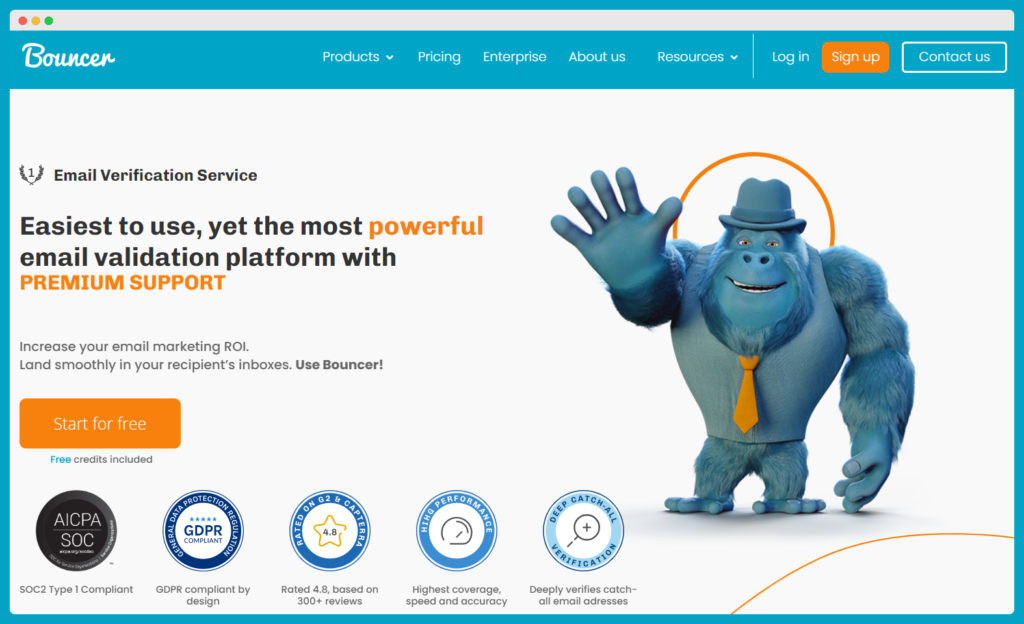How to Check an Email Address for Spam: A Comprehensive Guide
Landing in your recipient’s spam folder is no joy.
After all – you want people to open your emails and act upon them, right?

Now, how can you make sure they never miss your message?
Check out our comprehensive guide on how to stop your emails from getting marked as spam.
We’ll equip you with practical tips and insights to help you reach your audience’s inbox successfully.
Let’s improve your email deliverability!
Why should you check your email address for spam filters?

“Why should you care?”
In 2022, almost 50% of all emails sent around the world were identified as spam.
Now if your goal is to belong in the other 50%, you absolutely need to do something.
It will be extremely beneficial for you:
Avoid inbox detention
Checking email addresses for spam filters helps you prevent your emails from getting stuck in recipients’ spam folders.
Example: A company sent out a promotional email without spam checking, and it ended up in the spam folder of 30% of recipients. After implementing spam filter checks and adjustments, the spam folder placement was reduced to only 5%, resulting in a massive increase in open rates.
Maintain sender reputation
Regular checks ensure you maintain a good sender reputation, increasing the chances of your emails reaching the inbox.
Example: Imagine a business that consistently sends emails without spam checking. Over time, their sender reputation declined due to a high number of spam complaints.
Email service providers started flagging their emails as spam, and their inbox deliverability plummeted. By implementing regular spam checks and improving email content, they were able to gradually restore their sender reputation and regain access to the primary inbox.
Enhance email deliverability
When you identify and address spam filter issues, you improve the overall email deliverability of your important messages.
Example: A nonprofit organization relied heavily on email communication for fundraising campaigns. However, they struggled with deliverability issues as a significant portion of their emails got marked as spam. After implementing spam checks, their overall email deliverability improved by 15%. This improvement allowed them to engage with more donors and boost their fundraising efforts.
Maximize communication effectiveness
Checking for spam filters ensures that your emails reach the intended audience. The result? You maximize the effectiveness of your communication efforts.
Example: A retail company conducted A/B testing with two identical email campaigns, one without spam checking and one with spam checks in place.
The campaign without spam checking experienced a 12% higher bounce rate and a lower click-through rate of 6% compared to the campaign with spam checks. This showed the importance of spam checks in making sure that the message reached the right audience effectively.
What people think when you land in their spam folder
- “Uh oh, another spam email in the spam folder. Could this be another phishing email trying to steal my identity?”
- “I never signed up for these emails, it must be another unsolicited email filled with malicious links.”
- “My email server must be working hard to keep these phishing scams away from my inbox.”
- “I wonder if there are any important emails in here, or just more spam and potential identity theft threats.”
- “It’s frustrating to see my legitimate emails end up here while phishing scams somehow sneak through.”
- “Why does my email server keep flagging these emails as spam? I hope my email provider is doing its job.”
- “I trust my email client to filter out phishing emails, but what if one slips through?”
- “My email address must have ended up on some list for unsolicited emails. It’s a constant battle with these mail servers.”
- “I wonder if other email clients have better filters for identifying phishing scams.”
- “I need to be cautious of any email that lands in my spam folder, as it could contain dangerous links or simply be a phishing email.”
How to check if your email hits spam

It’s fairly easy to check whether or not your emails land in spam.
All you need to do is:
Use a spam checker tool before sending
Before hitting the send button, it’s like having a superpower tool to check if your email might end up in spam. These tools scan your email and give you a heads-up if something seems fishy.
💡 Useful tool: Bouncer
Test with multiple email providers
Different email services like Gmail, Yahoo, and Outlook may treat your email differently. So, send test emails to a bunch of these services (ideally from a few different IP addresses) to see if any of them put your email in the spam zone.
💡 Email providers to check include Gmail, Outlook, Yahoo Mail, Apple Mail, ProtonMail, Zoho Mail, AOL Mail, GMX Mail, Mail.com, Yandex.Mail, FastMail, Tutanota, and many others.
Monitor email open rates
Keep an eye on how many people open your email. If your open rate is super low, it could be chilling in the spam folder. People don’t usually check the spam folder, right?
💡 Top tricks:
- craft compelling subject lines to drive open rates
- segment your email list to send targeted content that appeals to specific interests
- A/B test different email elements like sender name, email design, and send times to optimize open rates
- keep a clean email list (remove inactive subscribers and verify email addresses)
- avoid using spammy words and excessive punctuation in your email content and subject lines
Check for trigger words in the subject line
Your email’s subject line can trigger spam alarms. Avoid words like “free,” “win,” or “money” that spammers often use. Be cool and honest in it.
💡 Words to check for: free, win, money, congratulations, urgent, guarantee, limited time, act now, cash, save
Verify SPF, DKIM, and DMARC records
These are like secret codes that prove you’re legit. Make sure they’re set up right. It’s like having a stamp of approval for your emails.
💡 Find out the basics behind SPF, DKIM, and DMARC here.
Send test emails to a control group
Before sending emails to your whole list, send it to a small group of trusted friends or colleagues. If it goes to their spam, you’ll know you’ve got a problem.
💡 Read our guide to email testing here.
Analyze bounce-back messages for spam flags
If your email bounces back with a message saying it’s blocked or marked as spam, take it seriously. It’s a warning sign that something’s not right.
💡 Useful tip: Check out our ultimate guide to email bouncebacks here.
How you can avoid spam filters with Bouncer

Here’s a detailed explanation of how to avoid spam filters using Bouncer:
Sign up for Bouncer
Begin by signing up for Bouncer’s email verification service. It’s an easy-to-use platform known for its accuracy and efficiency. You’ll need an account to access its features.
Import your email list
Once you have an account, you can import your email list into Bouncer. This step is crucial as it lets Bouncer begin the verification process. You can usually upload your list as a CSV or Excel file. This way it’s convenient for you.
Real-time verification
Bouncer provides real-time email verification. This means that as soon as you import your list, Bouncer starts checking the validity of each email address. Real-time verification makes sure that the email addresses on your list are currently active and valid.
Identify toxic emails
The tool goes way beyond basic email validation. That’s because it also checks for toxic email addresses. These can include widely circulated or breached email addresses, complainers, litigators, or potential spam traps. Identifying and removing these toxic emails from your list is essential to maintain your sender reputation.
Bulk verification
If you have a large email list, you can use Bouncer’s bulk verification feature. This feature allows you to verify entire batches of emails at once, saving you time and effort. It’s an efficient way to clean extensive lists quickly.
Improved deliverability
When you use Bouncer, you protect your sender reputation. Sending emails to invalid or toxic addresses can result in higher bounce rates and potential blacklisting. Bouncer helps you maintain a clean email list, ensuring your emails land smoothly in recipients’ inboxes.
Catch typos
One common reason emails bounce is due to typos in email addresses. Bouncer helps catch these typos, ensuring that you never lose valuable customers because of mistyped addresses. It’s a simple yet crucial aspect of email verification.
We also offer:
- boosted engagement
With a verified email list, you can boost engagement with your audience. Sending emails to high-quality, valid addresses increases the likelihood of converting leads into paying customers. Bouncer helps you focus on those who are genuinely interested in your content or products.
- integrations with marketing platforms
The solution offers seamless integration with various marketing platforms you may already be using. This integration makes it even more convenient to verify your email list for spam emails directly within your preferred marketing tools.
- premium support
Regardless of the size of your business, Bouncer provides premium support. If you have any questions or encounter issues during the verification process of your email spam score, Bouncer’s support team is available via email and chat to assist you promptly.
The list doesn’t end here. Sign up for Bouncer today and take your email marketing strategy to a whole new level.
Conclusion
So there you have it!
With these expert strategies in place, you can enhance your email marketing efforts and avoid the pitfalls of the spam bin.
Don’t wait. Take control of your email deliverability today and start reaching your audience’s inbox successfully.
It’s time to say goodbye to the spam folder and say hello to improved email marketing results.
P.S. Consider using Bouncer’s email verification service to proactively identify and remove toxic emails from your list, ensuring a clean and deliverable email list.





